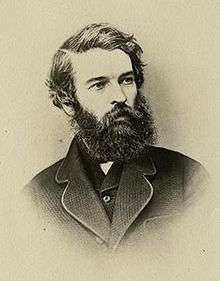Christopher Pearse Cranch

Christopher Pearse Cranch (March 8, 1813 – January 20, 1892) was an American writer and artist.
Biography
Cranch was born in the District of Columbia. His conservative father, William Cranch, was Chief Judge of the United States Circuit Court of the District of Columbia,[1] while his brother John was a painter.[2]
He graduated from Columbian College (now George Washington University) in 1835 before attending Harvard Divinity School and becoming a licensed preacher.[3] He traveled as a Unitarian minister, preaching in Providence, Andover, Richmond, Bangor, Portland, Boston, Washington, and St. Louis.[3] Later, he pursued various occupations: a magazine editor, caricaturist, children's fantasy writer (the Huggermugger books), poet (The Bird and the Bell with Other Poems in 1875), translator, and landscape painter. He lived much of his life in Cambridge, Massachusetts.
Though not one of its founding members, Cranch became associated with the Transcendental Club;[4] he read Ralph Waldo Emerson's Nature by December 1836 and beginning in June 1837 served as a substitute editor of the Western Messenger in the absence of James Freeman Clarke.[3] For that journal, Cranch reviewed Emerson's Phi Beta Kappa address at Harvard in August 1837 known as "The American Scholar". He referred to the speech as "so full of beauties, full of original thought and illustration" and its author as "the man of genius, the bold deep thinker, and the concise original writer".[5] Cranch's connection with the Transcendentalists ultimately diminished his demand as a minister.
His poetry was published in The Harbinger[6] and The Dial[7] among other publications. He sent "Enosis", which Hazen Carpenter noted as perhaps Cranch's most well-known poem, to Emerson for The Dial on March 2, 1840.[8]
_-_Cranch.jpg)
As an artist, Cranch painted landscapes similar to the work of Thomas Cole, the Hudson River school, and the Barbizon school in France. In one foray into historical painting, Cranch depicted the burning of P. T. Barnum's American Museum in New York City. Later in life, Cranch painted scenes from Venice and Italy. Cranch's caricatures of Emerson were later bound as Illustrations of the New Philosophy: Guide. Perhaps his most well-remembered and recognized artwork is a hand-drawn caricature illustrating Emerson's concept of the "transparent eyeball".[9] In 1850, he was elected into the National Academy of Design as an Associate Academician, and became a full Academician in 1864.
He died in 1892 and was buried at Mount Auburn Cemetery in Massachusetts.
Works
- Poems (1844)[9]
- The Last of the Huggermuggers, A Giant Story (1855)[9]
- Kobboltozo, A Sequel to the Last of the Huggermuggers (1857)[9]
- The Aeneid of Virgil (translation, 1872)
- Satan: A Libretto (1874)[9]
- The Bird and the Bell with Other Poems (1875)[9]
- Ariel and Caliban with Other Poems (1887)[9]
Further reading
- The Life And Letters Of Christopher Pearse Cranch: By His Daughter Lenora Cranch Scott (1917)
References
- ↑ Carpenter, Hazen C. "Emerson and Christopher Pearse Cranch" in The New England Quarterly. Vol. 37, No. 1 (March 1964): 26.
- ↑ David Bernard Dearinger; National Academy of Design (U.S.) (2004). Paintings and Sculpture in the Collection of the National Academy of Design: 1826-1925. Hudson Hills. ISBN 978-1-55595-029-3.
- 1 2 3 Carpenter, Hazen C. "Emerson and Christopher Pearse Cranch" in The New England Quarterly. Vol. 37, No. 1 (March 1964): 19.
- ↑ Gura, Philip F. American Transcendentalism: A History. New York: Hill and Wang, 2007: 7–8. ISBN 0-8090-3477-8
- ↑ Carpenter, Hazen C. "Emerson and Christopher Pearse Cranch" in The New England Quarterly. Vol. 37, No. 1 (March 1964): 20.
- ↑ Felton, R. Todd. A Journey into the Transcendentalists' New England. Berkeley, California: Roaring Forties Press, 2006: 126. ISBN 0-9766706-4-X
- ↑ Packer, Barbara L. The Transcendentalists. Athens, Georgia: The University of Georgia Press, 2007: 119. ISBN 978-0-8203-2958-1
- ↑ Carpenter, Hazen C. "Emerson and Christopher Pearse Cranch" in The New England Quarterly. Vol. 37, No. 1 (March 1964): 24-25.
- 1 2 3 4 5 6 7 Robinson, David. "The Career and Reputation of Christopher Pearse Cranch: An Essay in Biography and Bibliography" in Studies in the American Renaissance. 1978: 455.
External links
| Wikimedia Commons has media related to Christopher Pearse Cranch. |
| Wikisource has original works written by or about: Christopher Pearse Cranch |
- Works by Christopher Pearse Cranch at Project Gutenberg
- Works by or about Christopher Pearse Cranch at Internet Archive
- Works by Christopher Pearse Cranch at LibriVox (public domain audiobooks)

- Listing at American Transcendentalism Web